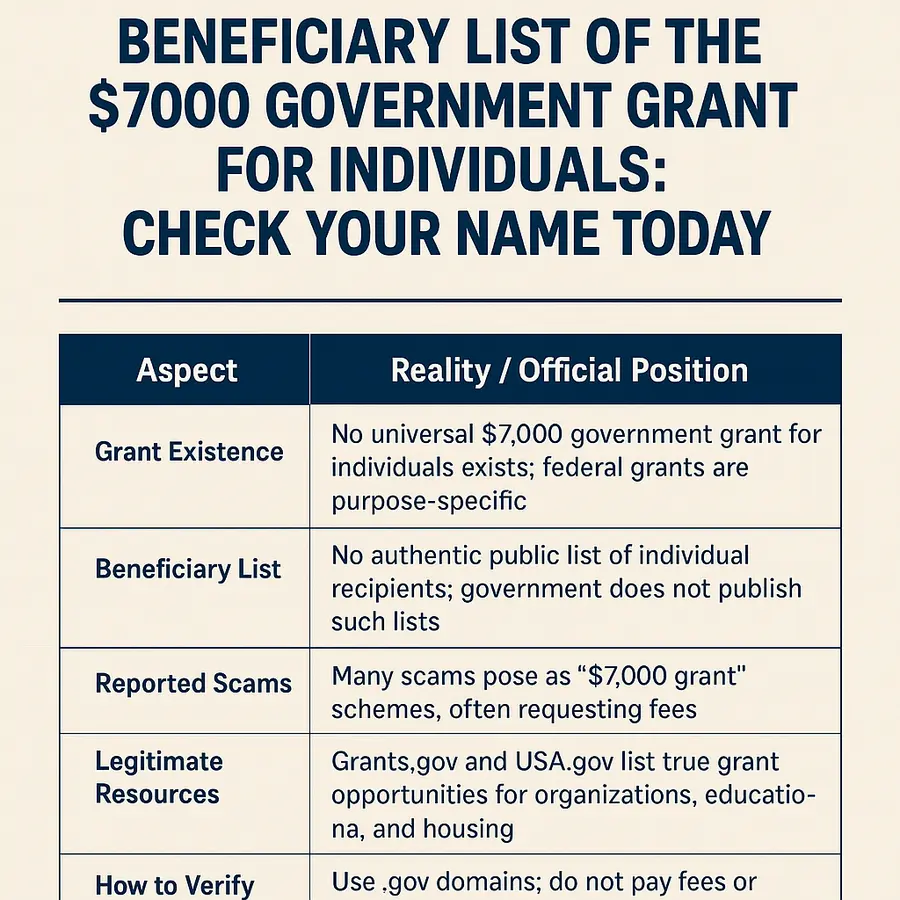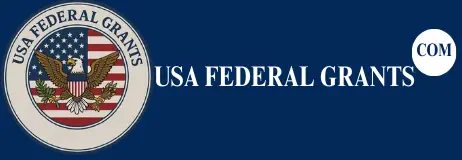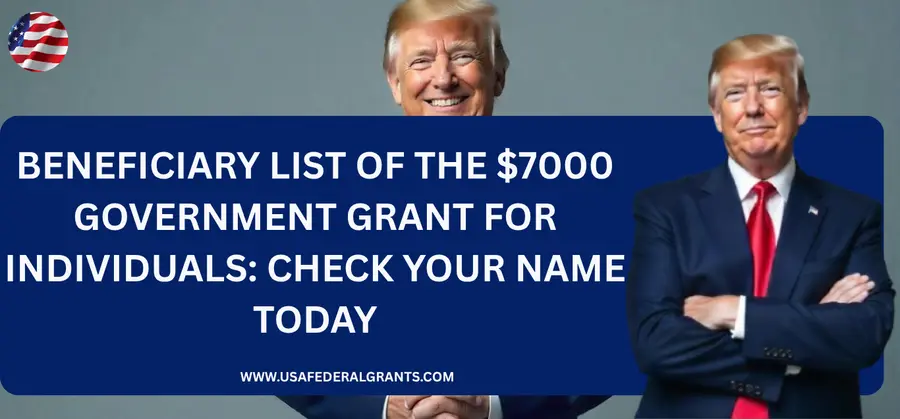There is currently no legitimate “beneficiary list of the 7000 government grant” released by any official U.S. federal or state government agency. Claims of universal, no-strings-attached $7,000 payments to individuals are unsupported by credible government evidence and are often associated with scams.

Table: Key Facts About the Alleged $7,000 Government Grant
| Aspect | Reality / Official Position |
|---|---|
| Grant Existence | No universal $7,000 government grant for individuals exists; federal grants are purpose‑specific (nationaldebtrelief.com) |
| Beneficiary List | No authentic public list of individual recipients; government does not publish such lists |
| Reported Scams | Many scams pose as “$7,000 grant” schemes, often requesting fees |
| Legitimate Resources | Grants.gov and USA.gov list true grant opportunities for organizations, education, and housing |
| How to Verify Grants | Use .gov domains; do not pay fees or provide personal info to unsolicited contacts |
Misconception Alert: No “Beneficiary List of the 7000 Government Grant”
Despite widespread references to the beneficiary list of the 7000 government grant, such a list does not exist on any official U.S. federal or state portal. Federal grants in the U.S. are typically allocated to organizations, nonprofits, educational institutions, or for specific purposes like research, housing subsidies, or business support—but not general cash grants to random individuals (nationaldebtrelief.com).
Claims of being “approved” for a $7,000 grant and urged to check a “beneficiary list” are consistent hallmarks of fraudulent schemes. The Better Business Bureau and federal watchdogs report scams claiming individuals are eligible for such payments, often accompanied by demands for a “processing fee.” These are warning signs of fraud (grants.gov).
Understanding How Real Federal Grants Work
- Institutional, Not Individual
Federal grant programs listed on Grants.gov are available only to entities like states, nonprofits, universities, and businesses—not individuals . - Purpose‑Specific Awards
When individuals receive federal aid, it’s typically through loans (like federal student loans) or means‑tested benefits (such as SNAP or TANF), not lump‑sum grants of $7,000 without oversight (grants-msje.gov.in, usa.gov). - No Fees or Unsolicited Offers
Official federal agencies will never solicit grant applications through calls, emails, or social media, nor ask individuals to pay fees for processing (pmay-urban.gov.in, consumer.ftc.gov). All procedures occur through secure government platforms such as Grants.gov or USA.gov.
Why the “Beneficiary List of the 7000 Government Grant” Myth Persists
- Marketing Tactics: Scammers employ buzzwords like “beneficiary list of the 7000 government grant” to appear official.
- Fear of Missing Out: Individuals may feel pressured to act quickly, fearing they’ll miss out on free funds.
- Lack of Awareness: Many people don’t realize federal grants have strict eligibility criteria and formal application processes through recognized agencies like the Dept. of Education or Health and Human Services (usa.gov, pmay-urban.gov.in).
Legitimate Financial Assistance That Could Total ~$7,000
While there is no universal $7,000 grant, some authentic U.S. programs may provide similar amounts for valid purposes:
- Pell Grants – Provide up to approximately $7,395 for undergraduates demonstrating financial need (nationaldebtrelief.com).
- Emergency Student Aid – Special funds (e.g., during the COVID‑19 pandemic) distributed to students through federal relief (HEERF).
- Small Business or Housing Grants – Federal and state apps may provide grants around that amount, but eligibility is narrow and tied to specific goals like disaster recovery or green initiatives.
Each program has its own application process and does not offer a public beneficiary list of individuals.
How to Safely Find Genuine Assistance
- Use Trusted Portals
Visit Grants.gov for federal funding opportunities targeting organizations (grants.gov). For personal grants or aid, use USA.gov, which routes users to benefits like housing or education. - Avoid Scams
Ignore unsolicited calls, emails, or websites claiming you’re pre‑approved for $7,000. Never provide personal or financial details or pay fees to “unlock” funds . - Research Specific Programs
If you’re a student, explore FAFSA (Pell Grants). If you’re a small business owner, check SBA grant opportunities. For veterans, check the Department of Labor or Health & Human Services for eligible awards (taggs.hhs.gov). - Consult Official Support
Use USA.gov or call 1‑844‑USAGOV1 to verify programs and report scams (usa.gov).
Conclusion
The beneficiary list of the 7000 government grant is not real. No legitimate government agency provides such a list for a general $7,000 payment to individuals. Always verify claims via trusted sources:
- Use .gov domains
- Avoid unsolicited offers and fees
- Apply only through recognized programs with defined purposes—like education, housing, or business development
For Further Information
- wbindia.in – State-level Indian welfare schemes
- khadyasathi.in – Food security initiatives in West Bengal
- rationcardindia.com – Centralized portal for ration card services
- banglastudentcreditcard.in – West Bengal student loan schemes
- Purihotelbooking.co.in – Tourism-related booking platform
- banglashasyabima.net.in – Agricultural insurance programs in Bengal
These sites are region-specific and unrelated to U.S. federal grants—but may be useful in their respective local contexts.
Read More: Apply Hardship Grants for Individuals Now 2025
firsthomeownergrants.com :- The First Home Owner Grant is a one-time government payment in Australia to help first-time buyers purchase or build a new home.


Pingback: Status Of The $7000 Government Grant: Official Updates And How To Verify Eligibility | USA Federal Grants
My name is felicia Joyner I live 121 Lakeview terrace apt.c Greenville NC 27834.I’m in a tight situation that I’m trying hard to get back on my feet.I need some help to put me back on track again. I need money to help me get a car so I can be able to get around..I trying so hard to get there so it seems like everything knocking me down. I don’t have a job right now. I been looking but there still no luck.Please try to help me as much u can to put me back on my feet.I would be glad if somebody can help me.I am a very nice church going lady that loves god.